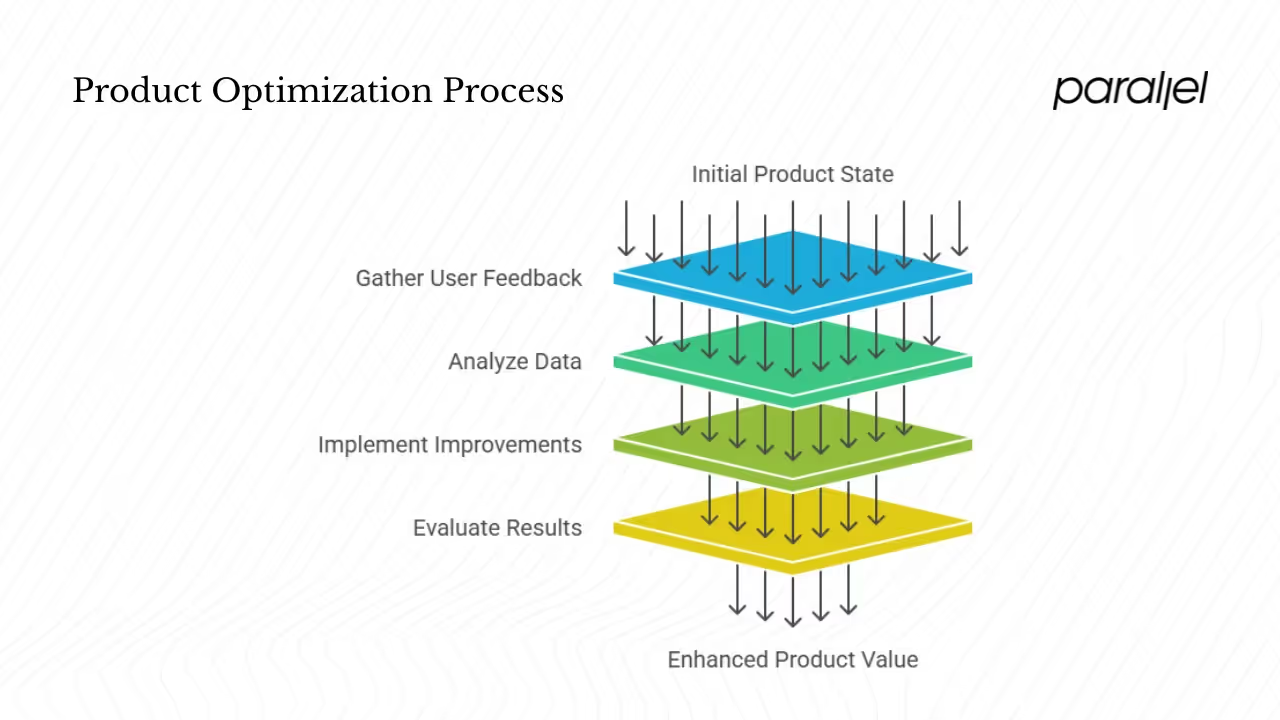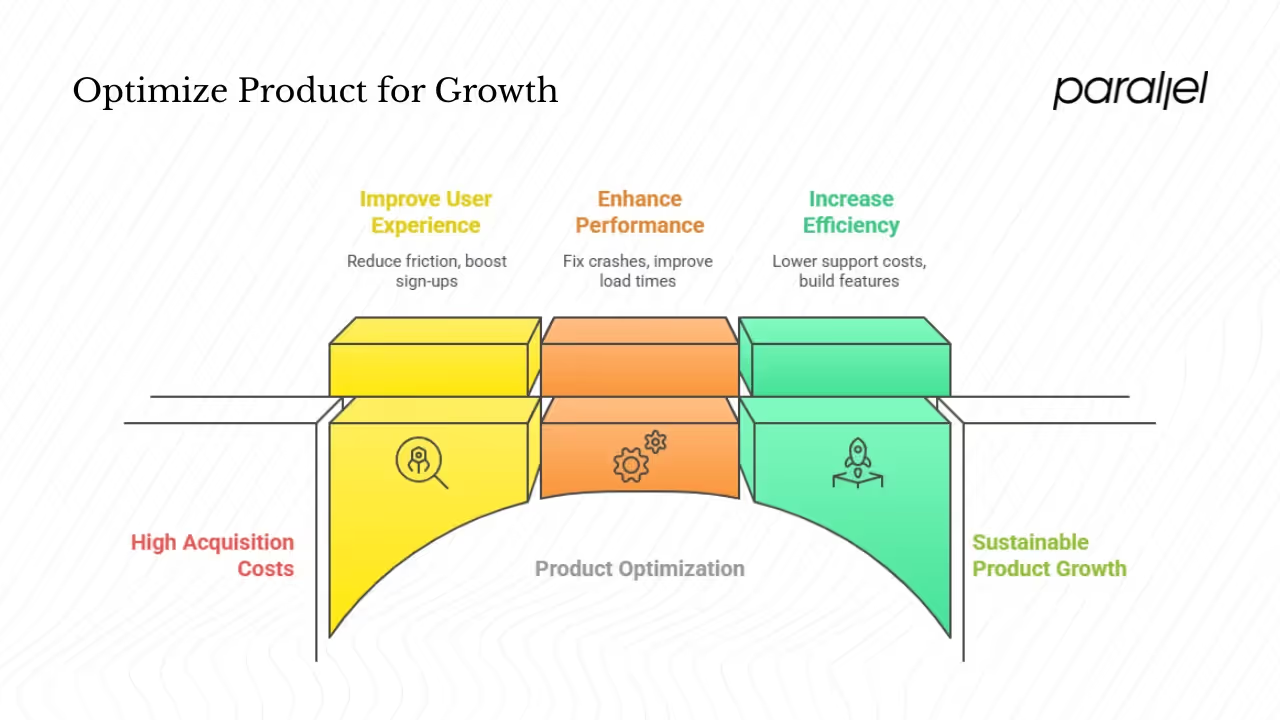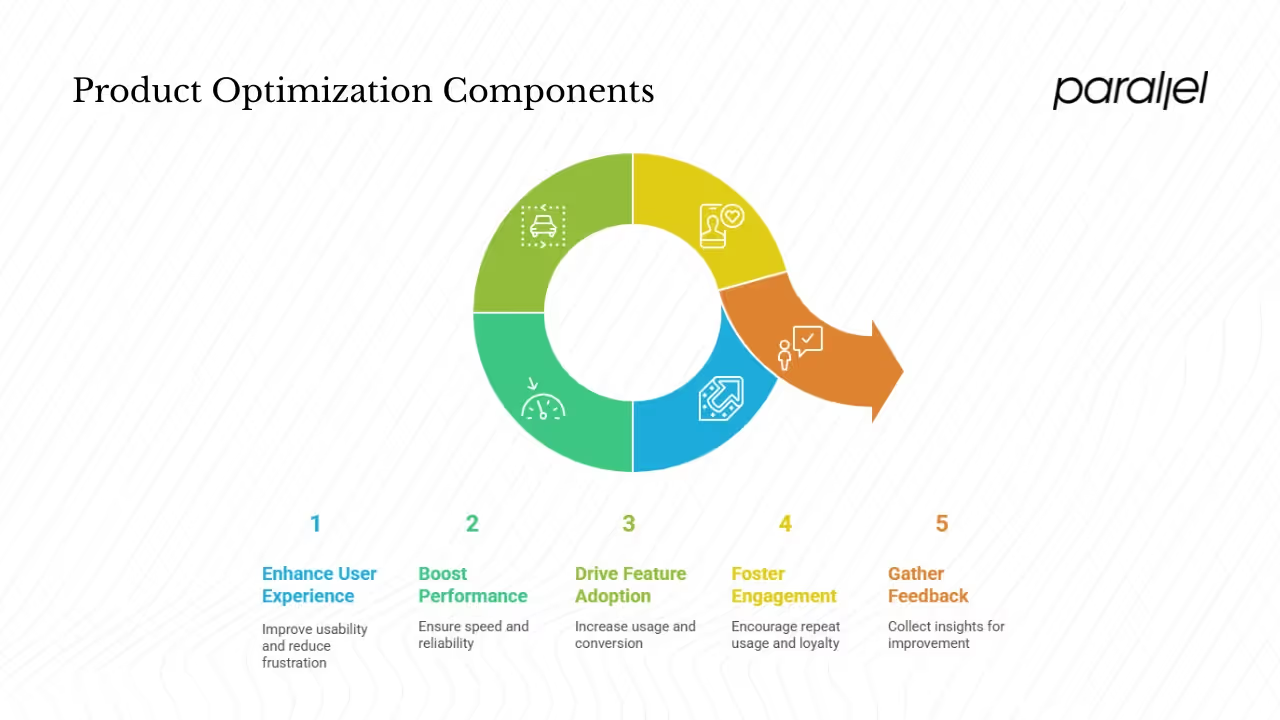What Is Product Optimization? Guide (2025)
Learn about product optimization, including data analysis, user feedback, and iterative enhancements to maximize product success.

Startups often launch a product that draws attention but people try it once and vanish. It’s tempting to blame marketing, but a better question is: what is product optimization and why do early‑stage teams overlook it? Product optimization means making small, evidence‑based improvements so your software becomes more valuable to customers and more attractive to new users. For founders and product leads, it’s the discipline of turning a working concept into a thriving business. This guide explains the idea, shows when to focus on it and how to do it, and includes tools, examples and concise answers to common questions.
What Is Product Optimization?
Authoritative sources describe product optimization in similar terms. ProductPlan defines it as “refining and improving a product to make it more valuable to current users and more attractive to new ones”. Userpilot echoes that view, describing it as a process of incremental tweaks that deliver more value and satisfaction while supporting business objectives. These definitions share two themes: it’s an ongoing process, and it centres on customer value. In other words, what is product optimization? It is the deliberate act of making many small improvements based on evidence so your product performs better for both the user and the business.

What it is not
It’s easy to confuse optimization with discovery. Product discovery is about identifying unmet needs and deciding what to build in the first place. Optimization comes after you have a baseline. Userpilot notes that discovery relies heavily on qualitative interviews, whereas optimization leans on experimentation and quantitative insights. Optimization isn’t only about shipping large features either. Often the biggest wins come from small improvements: reducing steps in an onboarding flow, clarifying copy, or fixing a painful bug. If you’re always chasing the next headline feature, you may miss dozens of smaller fixes that improve engagement.
Why product optimization matters
Rising acquisition costs and high churn make optimization a necessity. SimplicityDX reports that customer acquisition costs climbed 60% between 2019 and 2024 and over 70% of users abandon an app after the first day. In this environment, it’s cheaper to improve the product than to buy more traffic. When you ask yourself what is product optimization and why it matters, think about three outcomes:
- User experience and conversion. Small improvements reduce friction and boost sign‑ups. Inspire Fitness used UXCam data to refine content and flows, leading to a 460% jump in time spent and 181% more sign‑ups. Hotjar clients removed distracting buttons or moved popular plans higher on the page and saw conversion rates rise by 20% and 42% respectively.
- Performance and satisfaction. Fixing crashes, improving load times and adding features that match real behaviour increases trust and reduces support burden. Recora added a press‑and‑hold action after noticing older users long‑pressing; support calls fell 142%. When software is stable and responsive, people stick around.
- Efficiency and competitiveness. Optimized products lower support costs and stay ahead in crowded markets. Small UX gains differentiate you and increase lifetime value. Reducing churn and freeing your team from support calls creates room to build new features instead of firefighting.

When to focus on optimization
Once you’ve achieved product‑market fit and have real users, optimization becomes part of your job. If growth stalls, usage dips, or feedback highlights friction points, dig into your data instead of chasing more features. When crashes or slow load times hurt the experience, tackle performance and technical debt. Don’t wait until the product is mature—start with small improvements so continuous refinement becomes a habit.
Core components of optimization
Several dimensions influence how your software feels and performs. Thinking through each helps identify what to adjust:
- User experience and usability. Clear flows, intuitive copy and simple screens help people accomplish core tasks. Small tweaks such as better error messages or fewer input fields reduce frustration.
- Performance and reliability. Speed, crash rates and technical quality matter. Monitoring and resolving bottlenecks keeps your app responsive and builds trust.
- Feature adoption and conversion. Make sure existing features solve real problems and remove friction in sign‑up or purchase flows. Funnel analytics help you pinpoint drop‑offs and guide experiments.
- Engagement and retention. Track whether users come back and use important features. Improve onboarding, guidance and habit‑forming elements to encourage repeat use.
- Feedback and efficiency. Combine surveys, support tickets and interviews to understand satisfaction. Benchmark against competitors and measure cost savings from reduced support and churn.

A practical framework for optimization
When teams ask me what is product optimization in practice, I answer with a simple loop.
- First, define your objective: know which problem you want to solve and why.
- Second, choose metrics and a deadline to know when you’ll judge success.
- Third, collect evidence by analysing quantitative data (events, funnels, performance) and qualitative feedback (interviews, surveys, session replays).
- Fourth, prioritize ideas and run small experiments. Use impact‑versus‑effort thinking to pick promising changes, then build prototypes, A/B tests or feature flags to validate them.
- Finally, measure results and iterate. Compare outcomes to your baseline, roll back what doesn’t work and embed successful changes.
Repeat this cycle so continuous improvement becomes part of your planning.
Best practices and pitfalls
Best practices
- Keep improvements focused and measurable. Break big ambitions into small changes so you can trace cause and effect.
- Combine quantitative and qualitative insights. Analytics show where people struggle; conversations and session replays explain why.
- Test assumptions and involve cross‑functional peers. Experiments validate ideas, and collaboration with design, engineering and support yields better solutions.
Common pitfalls
- Tracking the wrong outcomes or none at all. Don’t rely on vanity metrics—use indicators tied to your goal and always have a baseline.
- Trying to fix everything at once. Focus on a few high‑impact problems instead of scattering efforts.
- Neglecting performance or user trust. A slow or unstable app undermines any surface improvements, and pushing conversions at the cost of trust harms loyalty.
Examples and case studies
Data‑driven stories show how powerful small adjustments can be. The Inspire Fitness team used session recordings and heatmaps to see which classes and features mattered most. By rearranging content and improving instructor quality they achieved a 460% jump in time spent, 181% more sign‑ups and a 40% drop in crashes. Recora noticed older users pressing and holding buttons like a physical remote; adding that interaction cut support calls by 142%. A car parts store using Hotjar found customers clicking a menu icon during checkout; removing it increased sales by 20%. On another site, moving a structured workout plan to the top of the page raised conversions from 9.1% to 14%. These varied examples share a theme: targeted tweaks informed by evidence deliver outsized returns.
Project management feature reminder (SaaS): In the Product School example, a team noticed users were missing task deadlines. Session recordings and surveys showed that reminders were too easy to overlook. The solution was to improve in‑app alerts and add Slack integration. After shipping the update, engagement improved and customer satisfaction scores rose (support tickets on this issue dropped by 40%).
These stories show that optimization is about removing friction and amplifying what works, not chasing flashy ideas. If someone asks what is product optimization in practice, point them to these examples.
Tools and methods you’ll likely use
Optimizing a product requires insight. A few categories cover most needs:
- Analytics and funnels: Event‑tracking tools help you see which features people use and where they drop off.
- Heatmaps, session replays and surveys: Visual and qualitative tools reveal what users do and why, complementing quantitative data.
- Experimentation and feature flags: A/B testing platforms and flag systems let you test ideas safely with small groups before rolling out widely.
- Performance and error monitoring: Crash and latency monitoring tools surface technical issues that damage trust.
Choose a lightweight stack that fits your stage. The goal is to turn behaviour into evidence, not drown in numbers. Even a simple analytics tool paired with user interviews can answer what is product optimization and guide improvements.
Balancing trade‑offs
Optimizing a product means weighing effort against impact. Early teams have limited bandwidth, so pick improvements with the highest payoff and accept that you can’t fix everything at once. Every change carries risk—use feature flags, small experiments and clear communication to avoid confusing users. Balance quick wins with maintainable code and check that local optimizations support your wider vision.
Insights from practice
At Parallel we’ve worked with many early‑stage tech and SaaS teams, and patterns repeat. Teams often overcomplicate onboarding to show everything at once. One client had a tour that walked users through nine screens before letting them touch the product. Session recordings showed that half of visitors quit during the tour. We worked with them to cut the tour to three screens and put a “Try it now” button at the top. Activation doubled and time to value dropped by about thirty percent.
Another client built a smart dashboard to “boost retention.” After analysing usage we realised people were leaving because pages took ten seconds to load and error messages were cryptic. Fixing performance and rewriting the messages increased daily active users and lowered support tickets without any new features.
These stories taught us to start with basics: clarity, speed and empathy. Fancy widgets may impress in demos, but they rarely compensate for a slow or confusing product. When in doubt, watch real users and listen to what they struggle with. The most meaningful wins often come from fixing what’s already there, not chasing the next big thing. These stories illustrate what is product optimization in real life: using evidence to make small, targeted improvements that deliver big results.
Conclusion
So what is product optimization? It is the disciplined act of making evidence‑driven improvements to an existing product so it serves users better and generates more value. For early‑stage founders and design leaders, this practice is the bridge between a promising prototype and a sustainable company. Pick one metric that matters and run one experiment. Repeat the cycle and build a habit of continuous refinement. Optimization isn’t a one‑time project; it’s a mindset that transforms how your team thinks about the product and builds a habit of improvements that pay off over time. If you still find yourself asking what is product optimization, revisit the case studies above. Share these ideas with your team, making them part of your way of working.
FAQ
1) How do you do product optimization?
Define a clear goal, pick metrics that relate to it, gather quantitative and qualitative data, test small ideas using experiments or feature flags, measure the results against your baseline and iterate with your team.
2) What is an example of production optimization versus product optimization?
Production optimization is about increasing output in manufacturing—adjusting machine settings to make more widgets. Product optimization improves a service or software for users. A simple example is the car parts store that removed a distracting menu icon and saw sales rise by 20%.
3) What are the five steps of optimization?
Identify a problem, gather and analyze data, brainstorm and prioritize fixes, implement them and evaluate the outcome—then repeat. This loop mirrors the cycle described earlier.
4) What is the role of product optimization?
It ensures an existing product continues to solve the right problems and support the business. By refining usability, conversion and performance you increase satisfaction, reduce churn and stay competitive.
5) How does optimization differ by product type?
SaaS or mobile apps focus on onboarding and adoption, consumer apps on engagement and habit, and hardware on reliability and manufacturing. In every case the same principle applies: use data and user insights to make the product better.
6) How often should you optimize?
Make optimization an ongoing rhythm. After each significant release, measure and refine. Even while building new features, carve out time for small fixes so continuous improvement becomes part of your routine.



.avif)









